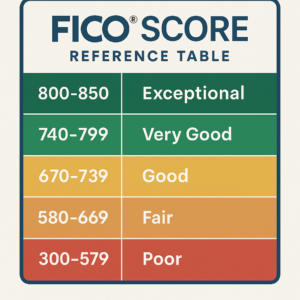How to Improve Your Bad Credit Score in 2025: A Step-by-Step Guide
Learn how to improve your bad credit score with practical steps, including using a credit utilization calculator to manage your credit effectively.
Published March 28, 2025

Struggling with a bad credit score and wondering how to improve it in 2025? You’re not alone—many people face the challenge of rebuilding their credit to unlock better financial opportunities, such as lower interest rates, easier loan approvals or even better rental agreements. A bad credit score – typically below 580 on the FICO scale – can feel like a major roadblock, but with the right strategies, like learning how to calculate credit utilization and using a credit utilization calculator to manage your credit, you can finally turn things around and set yourself up for success.
In this step-by-step guide, we’ll walk you through proven methods to improve your bad credit score. Moreover with a special focus on managing your credit utilization—a key factor that makes up 30% of your FICO score. We’ll also explain how to calculate your credit utilization, show you how to use a credit utilization calculator, and recommend tools like the Yendo Credit Card to help you rebuild credit without a hard credit check. Let’s get started on your path to better credit in 2025!
Disclosure: This post contains affiliate links, and I may earn a commission if you make a purchase at no extra cost to you. I only recommend products I thoroughly researched and trust.
Why Your Credit Score Matters in 2025
Your credit score is a three-digit number (ranging from 300 to 850 on the FICO scale) that reflects your creditworthiness. In fact, lenders, landlords, and even employers use it to assess your financial reliability.

Apply now.
A bad credit score can lead to:
- Higher interest rates on loans and credit cards.
- Difficulty getting approved for mortgages or rentals.
- Limited access to financial products.
In truth, improving your credit score opens doors to better financial opportunities. According to Experian, the average FICO score in the U.S. in 2024 was 715, and aiming for at least a “good” score (670–739) can make a big difference. Let’s dive into the steps to get there.
Step 1: Understand Your Credit Score and What Affects It
Before you can improve your credit score, you need to know where you stand and what factors influence it. For instance, the FICO score, the most widely used model, is based on five key components:
- Payment History (35%): Paying bills on time is the biggest factor.
- Credit Utilization (30%): The ratio of your credit card balances to your credit limits.
- Length of Credit History (15%): How long you’ve had credit accounts.
- Credit Mix (10%): A variety of credit types (e.g., credit cards, loans).
- New Credit (10%): Recent applications for credit.
For those with bad credit, focusing on payment history and credit utilization can yield the fastest results. Moreover, in this guide, we’ll zero in on credit utilization, as it’s a major lever you can pull to boost your score quickly.
Action Item: Check your credit score for free through services like Credit Karma or Experian. Review your credit report for errors (e.g., incorrect late payments) and dispute them with the credit bureaus (Equifax, Experian, TransUnion).
Step 2: Calculate Your Credit Utilization Ratio
What Is Credit Utilization?
Credit utilization is the percentage of your available credit that you’re currently using. It’s calculated as:
\[\text{Credit Utilization Ratio} = \left( \frac{\text{Total Credit Card Balances}}{\text{Total Credit Limits}} \right) \times 100\]For example, if you have two credit cards—one with a $500 balance and a $1,000 limit, and another with a $300 balance and a $2,000 limit—your total balance is $800, and your total limit is $3,000. Your credit utilization ratio is:
\[\left( \frac{800}{3000} \right) \times 100 = 26.67\%\]Why It Matters:
Credit utilization accounts for 30% of your FICO score, making it the second-most important factor after payment history. Experts, including those at FICO and Experian, recommend keeping your utilization below 30% to optimize your score. In addition, a high ratio (e.g., 70%) signals to lenders that you’re over-relying on credit, which can hurt your score significantly.
How to Calculate Credit Utilization Manually:
- List all your credit cards, their balances, and their credit limits.
- Add up your total balances (e.g., $800 in the example above).
- Add up your total credit limits (e.g., $3,000).
- Divide your total balances by your total limits and multiply by 100 to get the percentage.
Action Item: Calculate your credit utilization ratio today to see where you stand. If it’s above 30%, reducing it should be a priority.
Step 3: Use a Credit Utilization Calculator to Simplify the Process
First, calculating credit utilization manually can be time-consuming, especially if you have multiple credit cards. A credit utilization calculator makes it easy to determine your ratio and track your progress as you pay down debt.
Try Our Free Credit Utilization Calculator Below:
Use the interactive tool below to input your credit card balances and limits, calculate your overall utilization ratio, and get personalized AI advice on how to improve your credit score. You can also download a PDF report of your results to keep for your records.
| Card Name | Credit Limit ($) | Current Balance ($) | Utilization (%) |
|---|
Boost Your Credit with Yendo
Looking to improve your credit score? The Yendo Credit Card offers a great solution for those with bad credit:
- Up to $10,000 credit limit with no credit check
- Reports to all three credit bureaus to help build credit
- Lower APR (29.88%) compared to title loans (up to 300%)
Example Calculator Input:
- Credit Card 1 Balance: $500 | Limit: $1,000
- Credit Card 2 Balance: $300 | Limit: $2,000
Result: Your credit utilization ratio is 26.67%
How to Use the Calculator:
- Input the balance and credit limit for each of your credit cards.
- Click “Add Another Card” if you have more than one card.
- Click “Calculate Total Utilization” to see your overall ratio and get AI advice.
- Download your results as a PDF for future reference.
Why It Works: Using a credit utilization calculator helps you visualize your credit usage and set clear goals for reducing it, which of course, can directly improve your credit score over time.
Action Item: Use the calculator above to check your credit utilization ratio. Aim to lower it below 30% by paying down balances or increasing your credit limits.
Step 4: Lower Your Credit Utilization to Boost Your Score
Now that you know your credit utilization ratio, let’s explore strategies to reduce it and improve your credit score.
Strategy 1: Pay Down Your Credit Card Balances
The most direct way to lower your credit utilization is to reduce your credit card balances. Therefore, focus on paying off high-utilization cards first. For example, if one card is at 90% utilization ($900 balance on a $1,000 limit), paying it down to $300 will drop its utilization to 30%, significantly impacting your overall ratio.
Tip: Set up automatic payments or reminders to ensure you pay more than the minimum each month. Even small extra payments can make a difference over time.
Strategy 2: Request a Credit Limit Increase
If paying down debt isn’t immediately feasible, ask your credit card issuer for a higher credit limit. For example, if your $1,000-limit card increases to $2,000 and your balance stays at $500, your utilization drops from 50% to 25%. However, be cautious—requesting a limit increase may result in a hard inquiry, which can temporarily lower your score by a few points.
Tip: Only request a limit increase if you’re confident you won’t overspend with the extra credit.
Strategy 3: Use a Credit Card Designed for Bad Credit
For those with bad credit, getting approved for a credit limit increase or a new card can be challenging. This is where cards like the Yendo Credit Card come in. Yendo offers a vehicle-secured credit card with credit lines from $450 to $10,000, based on your car’s equity, without a hard credit check. By adding a new credit line, you can increase your total available credit, lowering your overall utilization ratio.
For a comprehensive review, check out my Yendo reviews for 2025 blogpost.
Example: If your current total credit limit is $3,000 with a $1,500 balance (50% utilization), adding a $4,000 Yendo credit line increases your total limit to $7,000. If your balance remains $1,500, your utilization drops to 21.4%—a significant improvement.
Action Item: Prioritize paying down high-balance cards, request a credit limit increase if appropriate, or consider a card like Yendo to expand your available credit. Click here to apply for it now. Recalculate your utilization ratio after each step to track progress.
Step 5: Make On-Time Payments to Build a Positive History
While credit utilization is crucial, payment history remains the largest factor in your credit score (35%) because it reflects your reliability to lenders. Moreover, late payments can stay on your credit report for up to 7 years, dragging down your score. To improve your bad credit:
- Set up automatic payments to ensure you never miss a due date.
- If you’ve missed payments in the past, contact creditors to negotiate removing negative marks (a “goodwill adjustment”) if you’re now in good standing.
- Use your credit card for small purchases and pay the balance in full each month to build a positive payment history.
Tip: If you’re using a card like Yendo, which reports to all three credit bureaus, on-time payments can steadily improve your score over time.
Action Item: Review your payment history on your credit report and set up reminders or autopay to ensure future payments are on time.
Step 6: Best Credit Cards for Bad Credit in 2025
Do you need to improve bad credit? Choosing the right credit card can accelerate your credit-building journey, especially if you have bad credit. Look for cards that:
- Don’t require a hard credit check (to avoid dinging your score).
- Report payments to all three credit bureaus (Equifax, Experian, TransUnion).
- Offer reasonable fees and interest rates.
One option to consider is the Yendo Credit Card, which offers up to $10K with no credit check, thus making it ideal for those with bad credit. Unlike traditional secured cards that require a cash deposit, Yendo uses your car’s equity as collateral, making it accessible for those with bad credit. It reports payments to credit bureaus, helping you build a positive history, and its APR of 29.88% is much lower than predatory title loans (which can exceed 300%). Plus, a higher credit line can lower your credit utilization ratio, as discussed earlier.
For a comprehensive review of Yendo, including user experiences and comparisons, check out my Yendo reviews in 2025 blogpost or apply now.
Other Options:
- Open Sky Secured Visa: Requires a cash deposit but has no credit check and a low annual fee ($35).
- Discover it Secured Card: Offers cashback rewards and a potential upgrade to an unsecured card after 7 months of good payment history.
For a deeper comparison of no credit check credit cards, check out our guide on comparing Yendo to other options in 2025.
Action Item: Research credit cards for bad credit and apply for one that fits your needs, like Yendo, to start building a positive credit history.
Step 7: Monitor Your Progress and Stay Consistent
Improving your credit score is a marathon, not a sprint. Therefore, you must monitor your progress regularly to stay motivated and adjust your strategies as needed:
- Check your credit score monthly through free services like Credit Karma or your bank.
- Use a credit utilization calculator to track your ratio as you pay down debt or add new credit lines.
- Review your credit report annually (or more often if you’re actively rebuilding) at AnnualCreditReport.com to ensure accuracy.
Consistency is key—making on-time payments, keeping your credit utilization low, and avoiding new hard inquiries will gradually improve your score. According to FICO, significant improvements can take 3–6 months, but small changes (like lowering utilization) can show up in as little as 30 days.
Action Item: Set a monthly reminder to check your credit score and utilization ratio. Celebrate small wins, like dropping your utilization below 30%, to stay motivated.
Frequently Asked Questions About Improving Your Bad Credit Score
What is a credit utilization calculator, and how does it help?
A credit utilization calculator helps you determine the percentage of your available credit you’re using. Keeping this ratio below 30% can boost your credit score by showing lenders you’re not over-relying on credit.
How do I calculate my credit utilization ratio?
Add up your credit card balances and divide by your total credit limits, then multiply by 100. For example, $1,000 in balances with $5,000 in limits equals a 20% utilization ratio. (Click here to access our Credit Utilization Calculator)
Can a credit card like Yendo really help with bad credit?
Yes! Yendo offers credit lines up to $10,000 with no credit check, reports payments to credit bureaus, and can lower your credit utilization by increasing your available credit. Learn more in my review here.
How long does it take to improve a bad credit score?
It depends on your starting point, but you can see improvements in 1–3 months by lowering credit utilization and making on-time payments. Major improvements may take 6–12 months.
Conclusion: Take Control of Your Credit in 2025
Improving your bad credit score in 2025 is entirely possible with the right strategies. By focusing on your credit utilization—using tools like a credit utilization calculator—and making on-time payments, you can start seeing results in as little as 30 days. Cards like the Yendo Credit Card can accelerate the process by providing accessible credit without a hard credit check, helping you lower your utilization and build a positive payment history.

They make it so easy. They build credit. You get the money instantly and it’s easy to pay. What more could you say? Go ahead, do it. Get it done and see what happens. Great things.
Click here to see the full review.
Inspired by Garret’s great advice? Take the first step toward rebuilding your credit today!
Ready to rebuild your credit? Apply for the Yendo Credit Card now!

So, are you ready to get started? Calculate your credit utilization ratio today, explore credit cards for bad credit, and take the first step toward a better financial future. For more insights on Yendo, check out my detailed Yendo Credit Card review for 2025 or apply now.
Have you tried any of these strategies? Share your experience in the comments below—I’d love to hear your story!